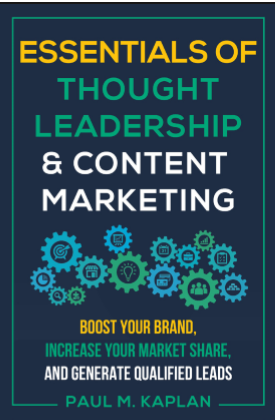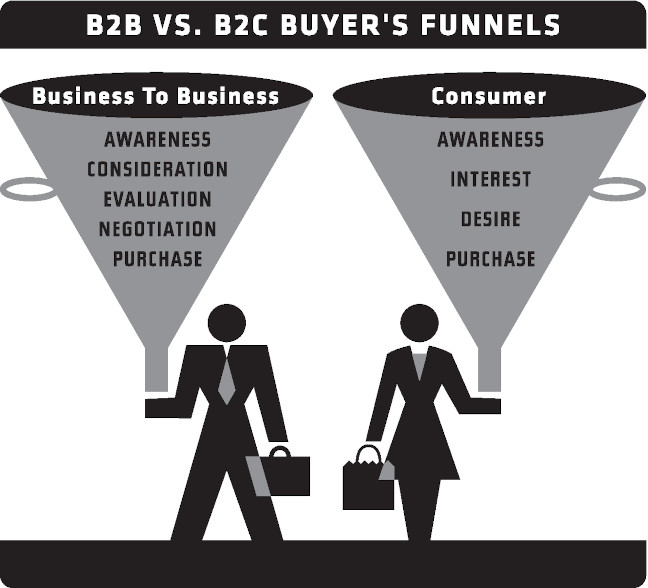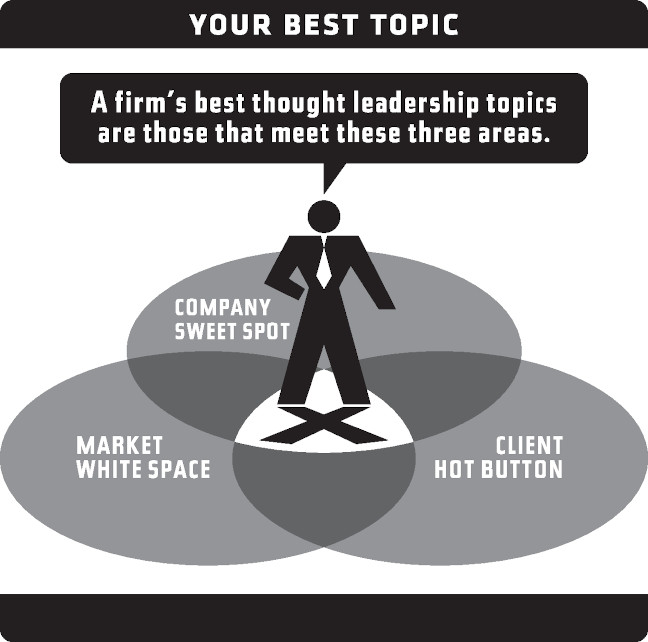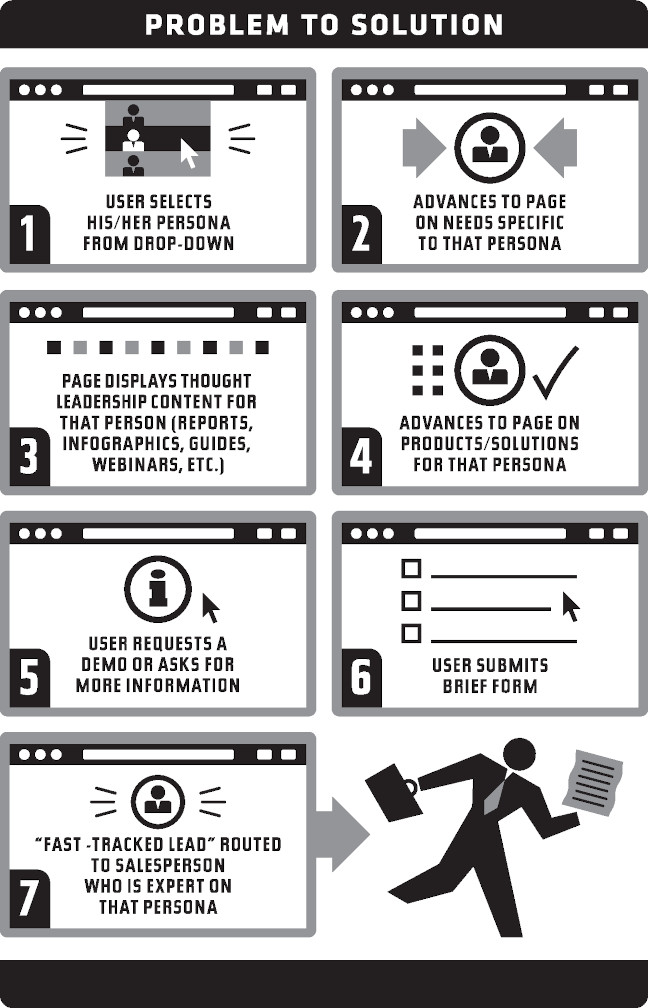Essentials of Thought Leadership and Content Marketing
New Marketing Book “Connects the Dots” of Thought Leadership, Lead Generation, and Sales Enablement

Published by Quill Driver Books/Linden Publishing, this book is a “how to” for any company, agency, start-up, or non-profit. It shows how any organization can boost its brand, increase market share, generate leads, and close more sales through a robust content marketing program. The book walks through how to create a content plan and map to the buyer’s journey, make it PR worthy and pitch it effectively to the media, create campaigns and automation tools, enact lead generation and routing, and effectively partner with sales teams.
Rather than just summarizing the process of doing effective content marketing, the book shows step-by-step how to perform it. Essentials of Thought Leadership and Content Marketing advises readers on how to handle common challenges like interviewing subject matter experts when none internally seem to exist, showing value to management, reporting on “hard to measure metrics,” working with reluctant sales teams, and enticing jaded users.
Other topics include:
- Developing a thought leadership and content strategy
- Creating a content marketing plan
- Mapping contents to the buyer’s journey
- Engaging the industry through smart PR
- Leveraging social media and other channels
- Pay Per Click (PPC) advertising and Search Engine Optimization (SEO)
- Building a marketing infrastructure with automation tools
- Lead generation and lead nurture
- Collaborating with sales teams
- Measuring your ROI
The book draws upon interviews with a diverse set of organizations including:
- IBM (business to business)
- Whole Foods (consumer)
- American Express OPEN (small business)
- Trusted Media Brands (advertiser market)
- Museum at Eldridge Street (non-profit)
- Several consulting firms
- Industry research firms and “think tanks”
The book is filled with diagrams to illustrate concepts.



Reviews
Critics and practitioners are lauding the book for its innovation and practicality.
“In this book, Paul has captured all the practical essentials that a thought leadership marketer needs: how to decide which content to develop and how to produce and market it. This book is not another breathless celebration of the virtues of content or thought leadership marketing; it’s an invaluable handbook for getting the job done!”
-Tim Parker, Partner, Bloom Group, Boston, MA
“Impressively informative, expertly written, organized and presented … recommended reading for marketers, advertising professionals, and entrepreneurs.”
-Wisconsin Bookwatch
Buy a copy here.
I do book talks or mini workshops for all kinds of organizations for very reasonable fees or multiple book purchases. It’s ideal for a company, marketing agency, or entrepreneur.
Contact me for more information.
View other books I have published in Social History, Biographies, and Cultural Travel Guides.
Excerpt from Book
What is Thought Leadership? Let’s start with definitions. The term “thought leadership” is often used but what does it really mean? What is the difference between content marketing and thought leadership? After we define these, we’ll look at their role in your marketing efforts. Thought leadership is a sub-set of content marketing. At its best, thought leadership brings a fresh perspective to the marketplace on a particular issue. For example, it may explain the effect of a regulation or a market shift. Besides outlining the situation, excellent thought leadership will chart a course of action. It’s not enough to define the problem or issue, the piece should guide the reader. The most helpful thought leadership also offers commercial insights so readers can see how to improve their business. Ultimately, a mark of distinction for thought leadership is whether it can bring value to readers’ organizations.
John Miller, VP Product Marketing for Marketo, notes that “both thought leadership and content marketing can very effectively build your awareness and brand, but…true thought leadership is much rarer. Thought leadership consists of ideas that require attention, that offer guidance or clarity and that can lead people in unexpected, sometimes contrarian directions. Thought leadership needs to be educational and ideally provocative; content marketing can simply be fun or entertaining.”
LinkedIn, a key platform for socializing thought leadership, offers its perspective as well. “Thought leadership is about sharing insights and ideas—and a unique point of view—that provoke new ways of thinking, spark discussions and debates, and inspire action. A true thought leader knows a topic inside and out, has formed a clear, unique and defensible point of view about it, and freely shares that perspective.”
As Jeff Ernst, principal analyst at Forrester Research puts it: “Business buyers don’t ‘buy’ your product or service, they ‘buy into’ your perspective and approach to solving their problems.” Part of the payoff of thought leadership is for a company to elevate out of the competitive product minutia discussions to uncommitted buyers and to engage buyers at the strategic level. Studies show that companies value—even crave—a unique perspective from vendors. Respondents placed a high value in breadth and depth of information as well as originality of thinking and ideas. Another benefit of thought leadership is that it allows your company to engage clients.
There are three basic steps for building a thought leadership framework:
1. Understand the issues and opportunities of your prospects and clients.
2. Create a roadmap of how you think industry players should react
3. Show the value delivered to prospects and clients by helping them see out of the box.
Marketers often miss the last point. Often, companies do not link their thought leadership to their clients’ and prospects’ business value. Without this, buyers cannot implement their findings into action. It is like giving them a forecast for a snowy day but not mentioning that they should wear snow boots, a scarf, and gloves. Thought leadership must, in the end, map topics that address their audience’s key issues and provide solutions for solving them. Put another way, marketers must ensure there’s “consistency in their company’s mission and vision, what the company delivers in the market, and its marketing messages. This is key to making sure there’s muscle behind getting your thought leadership noticed.”
